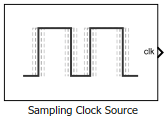Sampling Clock Source
Generate clock signal with aperture jitter
Libraries:
Mixed-Signal Blockset /
ADC /
Building Blocks
Description
The Sampling Clock Source block generates either a sine wave or square wave clock with aperture jitter impairments.
Ports
Output
Output clock signal with aperture jitter, returned as a scalar. The clock is a periodic pulse train that can be a sine wave or a square wave, based on the Clock type parameter.
Data Types: double
Parameters
Shape of the output clock signal.
Square wave— Returns a square wave of 1 volts amplitude and specified frequency.Sine wave— Returns a sine wave of 1 volts amplitude and specified frequency.
Programmatic Use
Block parameter:
SignalType |
| Type: character vector |
Values:
Square wave | Sine
wave |
Default:
Square wave |
Desired frequency of the output clock signal, specified as a scalar in hertz.
Programmatic Use
Block parameter:
Freq |
| Type: character vector |
| Values: scalar |
Default:
1e6 |
Minimum voltage of the output clock signal, specified as a real scalar in volts.
Programmatic Use
Block parameter:
Min |
| Type: character vector |
| Values: real scalar |
Default:
0 |
Maximum voltage of the output clock signal, specified as a real scalar in volts.
Programmatic Use
Block parameter:
Max |
| Type: character vector |
| Values: real scalar |
Default:
1 |
Standard deviation of clock edge locations, generated by an impaired clock with respect to an ideal clock. RMS aperture jitter is specified as a real nonnegative scalar in seconds.
Aperture delay is the delay between sampling clock signal and the actual instant when the sample is taken. Aperture jitter is the sample to sample variation between aperture delay. Aperture jitter results in an error voltage in ADC that is proportional to the magnitude of the jitter and the slew rate of the input signal to ADC.
Programmatic Use
Block parameter:
RMSJitt |
| Type: character vector |
| Values: nonnegative real scalar |
Default:
1e-12 |
Advanced
Select to specify a custom seed for generating the clock signal. By default, this option is deselected.
Seed for generating the clock signal, specified as a nonnegative real scalar.
Programmatic Use
Block parameter:
Seed |
| Type: character vector |
| Values: nonnegative real scalar |
Default:
0 |
Dependencies
To enable this parameter, select Specify custom seed in the Advanced tab.
Select to specify a custom initial output for the sampling clock source. By default, this option is deselected.
The initial output of the sampling clock source, specified as a real scalar.
Programmatic Use
Block parameter:
InitialOutput |
| Type: character vector |
| Values: real scalar |
Default:
0 |
Dependencies
To enable this parameter, select Specify custom initial output in the Advanced tab.
Select to enable increased buffer size during simulation. This increases the buffer size of the Variable Pulse Delay block inside the Sampling Clock Source block. By default, this option is deselected.
Number of samples of the input buffering available during simulation, specified as a positive integer scalar. This sets the buffer size of the Variable Pulse Delay block inside the Sampling Clock Source block.
Selecting different simulation solver or sampling strategies can change the number of input samples needed to produce an accurate output sample. Set the Buffer size to a large enough value so that the input buffer contains all the input samples required.
Dependencies
To enable this parameter, select Enable increased buffer size in the Advanced tab.
Programmatic Use
Block parameter:
NBuffer |
| Type: character vector |
| Values: positive integer scalar |
Default:
50 |
Version History
Introduced in R2019a
MATLAB Command
You clicked a link that corresponds to this MATLAB command:
Run the command by entering it in the MATLAB Command Window. Web browsers do not support MATLAB commands.
Select a Web Site
Choose a web site to get translated content where available and see local events and offers. Based on your location, we recommend that you select: .
You can also select a web site from the following list
How to Get Best Site Performance
Select the China site (in Chinese or English) for best site performance. Other MathWorks country sites are not optimized for visits from your location.
Americas
- América Latina (Español)
- Canada (English)
- United States (English)
Europe
- Belgium (English)
- Denmark (English)
- Deutschland (Deutsch)
- España (Español)
- Finland (English)
- France (Français)
- Ireland (English)
- Italia (Italiano)
- Luxembourg (English)
- Netherlands (English)
- Norway (English)
- Österreich (Deutsch)
- Portugal (English)
- Sweden (English)
- Switzerland
- United Kingdom (English)
